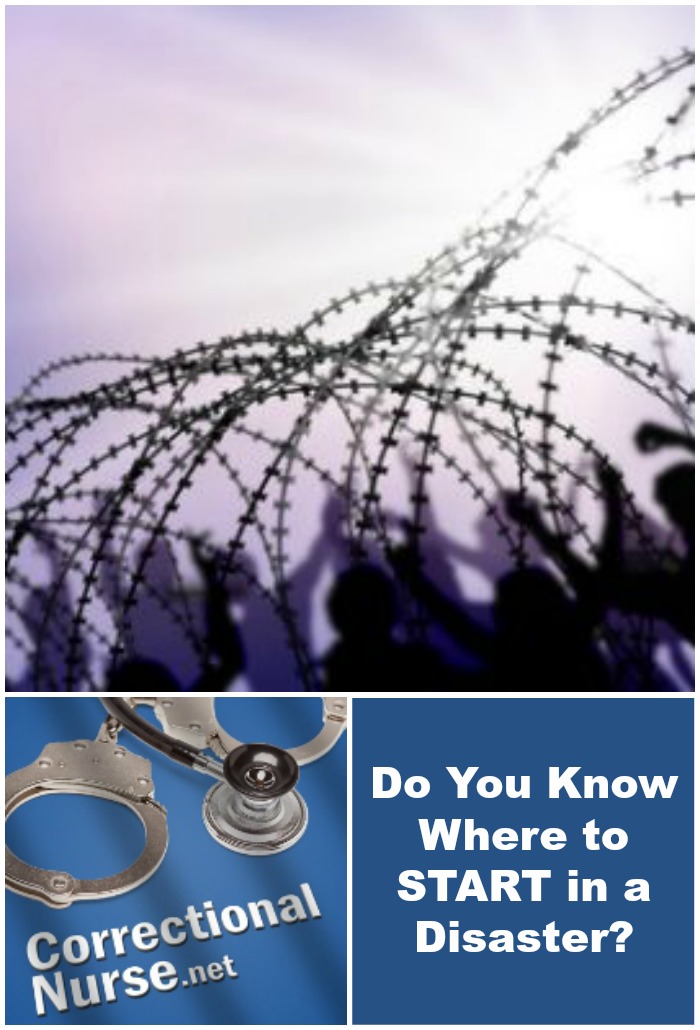Correctional Nurse, Benjamin S Kanten, MBA, MSN, RN, CCHP-RN, shared the START process during a session at the 2013 NCCHC Spring Conference. Here are my notes from the session.
 Are you prepared to handle a mass casualty at your facility? Do you even know what would be considered a mass casualty in your setting? A mass casualty situation could be a natural disaster, illness outbreak, an accident in the inmate shop, or a transport accident. Your facility may house political action groups or gangs who engage in extreme behaviors that lead to group traumatic injury. A prison riots could result in mass casualties. Natural disasters also make the list – Hurricanes or tornados can move through the area. Pandemics such as H1N1 flu can lead to a casualty situation requiring triaging efforts.
Are you prepared to handle a mass casualty at your facility? Do you even know what would be considered a mass casualty in your setting? A mass casualty situation could be a natural disaster, illness outbreak, an accident in the inmate shop, or a transport accident. Your facility may house political action groups or gangs who engage in extreme behaviors that lead to group traumatic injury. A prison riots could result in mass casualties. Natural disasters also make the list – Hurricanes or tornados can move through the area. Pandemics such as H1N1 flu can lead to a casualty situation requiring triaging efforts.
Nurses are focused on doing the best for each patient. This value serves us well in most situations. However, doing the greatest good for the greatest number of people is the primary principle in a disaster situation. This might even involve rationing care. Simple Triage And Rapid Treatment (START)is an objective triage tool that was originally developed by the Newport Beach Fire Department and spread throughout the emergency response community. This easy-to-remember and easy-to-perform system is designed to rapidly triage a large number of casualties. In fact, it takes as little as 30 seconds to assess each victim using this process.
An excellent feature is that, with training, anyone can perform a START evaluation; a medical background is not requires. In fact, non-clinicians seem to do this well; possibly because they are less likely to overthink the situation. In triage, we are determining medical need, not providing patient treatment.
Traffic Light System
The familiar Green-Yellow-Red traffic light system is the basis for victim identification. It is important to use the same tag system as the local EMS group for rapid patient hand-offs.
- Green – first aid and/or minor medical treatment is needed. These victims may be able to provide self-care or have treatment delayed for hours or days.
- Yellow – requires treatment beyond first aid, however, treatment can be delayed for some time.
- Red – immediate treatment needed to preserve life – this could mean airway problems, open fractures, or significant bleeding
- Expectant – this tag (black) is reserved for those with major wounds that will require significant resources to treat. These individuals will likely die no matter what is done.
START Steps
The priority of disaster casualty management is to preserve the greatest number of lives. Here is a step-by-step guide to the START process.
- STEP 0 – Secure the Scene: Scene safety first. This is always true during a correctional emergency. However, in a disaster, there are additional safety issues. For example, there may be another bomb.
- STEP 1 – Instruct everyone who can walk to go to a designated area. These are the Green tags
- STEP 2 – Check RPMs on remaining victims. RPM is a mnemonic for Respiration, Perfusion, Mental Status.
- STEP 3 – Tag victims based on the RPM evaluation.
RPM – 30 – 2 – Can Do
The Respirations/Perfusion/Mental Status evaluation quickly determines if a person needs immediate or delayed attention. In order to be placed into the Yellow (delayed attention) category they need to have:
- Respirations less than 30
- Capillary Refill (perfusion) less than 2 seconds
- Mental Status indicationing that they are conscious and able to follow commands
Victims who do not meet one of these requirements go into the Red (immediate attention) category unless they are not breathing even after opening their airway. In that case, they are considered Expectant (Black).
Here is a flowchart created by CERT Los Angeles that graphically explains the process
Are you prepared for a mass casualty incident at your facility? What do you use for your triage process? Share your experiences in the comments section of this post.
Photo Credit: © Benjamin Haas – Fotolia.com

Laurie Weyant says
So true. Been there a few time in a prison riot.